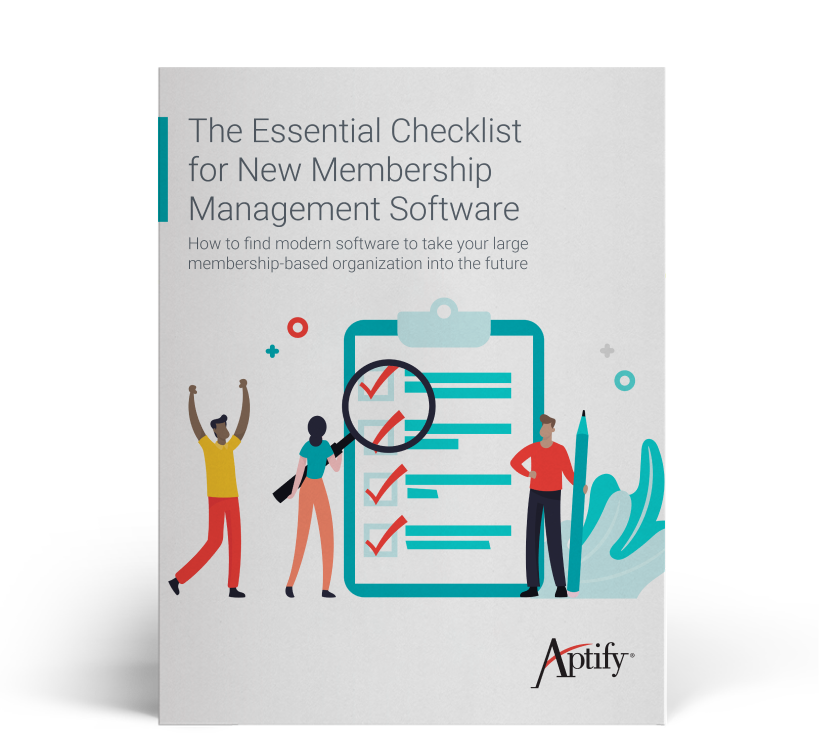There are dozens of membership management software options on the market today. Read on to learn strategies for choosing the software that’s right for your organization.
Looking for new membership management software for your large association or labor union isn’t always easy. There are dozens of options in the marketplace. And with a decision as big as which software you’ll use to manage your organization, it’s important to find the right fit.
Here are four key strategic areas to consider as you choose your next membership management software:
1. Which membership management software capabilities are right for your organization?
A helpful place to start when considering the right membership management software for your organization is to think about what capabilities you need. Consider your organization’s size (staff, membership, annual revenue) and how much flexibility you need in membership management software.
For example, based on the size and complexity of your staff and membership levels and processes:
- If your organization does not require a great deal of flexibility, then an “off-the-shelf” solution built for small or large organizations (depending on your organization’s size), might be right for you. These solutions typically have baseline functionality that most associations and unions need and sometimes allow for basic configuration.
- If your organization is small, but complex, then you might choose an “off-the-shelf” solution and add applications to handle various aspects of your association or union management.
- If your organization is large and complex, then your best option is likely membership management software for large organizations that’s built on an enterprise-level development platform. These types of solutions offer deep and broad functionality and allow you to substantially configure and tailor the system to your needs.
Other considerations include:
- What type of platform the software is built on
- Whether the software is hosted by the vendor or on-premises at your organization
- Whether the software is configurable or fully customizable
- How easy the software is for non-technical staff to use
Your decisions around most of these points will depend on the size of your IT staff, how much control your IT team wants over the software, and other IT checklist items.
2. Which software vendor is the right match for your organization?
Once you’ve narrowed your list of options, it’s time to start reviewing your top candidates. A good place to start is to research the software vendors on your shortlist.
Here are some areas to consider when selecting the right software vendor for your organization:
- Trust/reliability – Ask the vendor how long the company has been in business. Also, ask for a list of some of the vendor’s top customers and see if you can contact them for a reference.
- System processes and data migration – Make sure you understand the vendor’s approach to data and data processes. For example, ask the vendor:
- What is the process of migrating your data into their system?
- Is there a data cleanup process before migrating the data, and who is responsible for it (you or the vendor)?
- Can data in the membership management software sync with any other applications you might have?
- Configurability and upgrade path – Ask about the platform’s flexibility and configurability. Make sure you understand any restrictions so that you know any configurations or customizations you make won’t break when the system is upgraded to a new version. Also, ask who is responsible for maintaining and upgrading the system (you or the vendor?).
- Training – Ask about what training the vendor provides for the system. Are training options one-time, ongoing, or both? Are courses in-person or online (or both)?
- Team functions and support – What is the vendor’s implementation process? What is the process for handling any issues that might arise during installation? After the system is up and running, how will the vendor work with you? What is the customer support process? Is there a community of users that you can turn to for added support and idea-sharing?
3. How much will the new membership management software cost?
The cost of membership management software isn’t always as straightforward as you might think. Multiple factors go into the cost of new software. Also, pricing between any two software options is not always an apples-to-apples comparison.
What’s most important is the true cost of owning the system over time and making sure the system meets your organization’s needs. Here are some key considerations as you think about the cost of new membership management software:
- Users – The number of people using your software will impact the price. Some vendors charge by membership volume (actual number of members logging into your member site), and some charge only for the number of your staff members using the software. Be sure to ask the vendor about this.
- Implementation – Ask the vendor about what functionality comes with the system and what functionality you might need to configure or build on your own. Be sure to have well-defined business requirements in place so that your vendor can give you an accurate estimate of what will be required.
- Operating costs – Operating (also called ongoing) costs are non-personnel costs associated with keeping the system running and maintained. These costs can include licensing fees, upgrade costs, support fees, and hardware and/or hosting costs. Be sure to ask the vendor about estimated costs for these items.
- Long-term costs and lifetime value – The investment you make now will have a direct impact on how much you must spend in years to come. The cost to maintain your membership management software at the level required to run your business can quickly increase over time if the software you choose today can’t adapt to changing needs. Look at the total cost of ownership of any system by asking questions, such as:
-
- Will you need to re-implement your system in a few years because the software is too complex to upgrade?
- Is your system built on a platform that allows for change, or will your modifications have to be rebuilt with each product upgrade?
- Is your software able to support the latest technological innovations as they evolve?
For any membership management software you consider, ask the vendor about their customer retention rate, ask customer references about their product upgrade experience and the cost of the system over time, and check on how the system has been able to keep up with the customers’ changing needs.
4. Will the software prepare your organization for growth?
Speaking of changing needs, it’s important to remember that your organization will grow and evolve over time. Consider how the software you choose will support your plans for the future. For example:
- Does the software support international capabilities? If your organization operates (or plans to operate) internationally, make sure the software is ready to support you. It should offer multi-currency and multi-language capabilities, Unicode characters, and multi-time zone support.
- Can the software handle complex local/chapter management? If your organization adds and grows chapters, can the software handle complex fee structures and dues payments? How easy is it to manage and report on chapter data and
processes?
- How scalable is the technology? For example, how easy it is to configure, update, add modules to, and integrate with other systems as your organization grows?




 processes?
processes?

